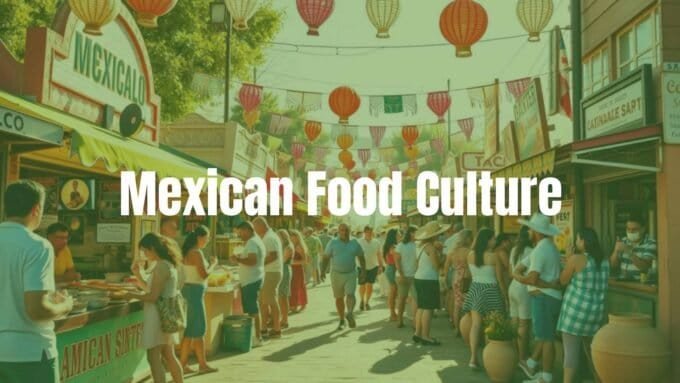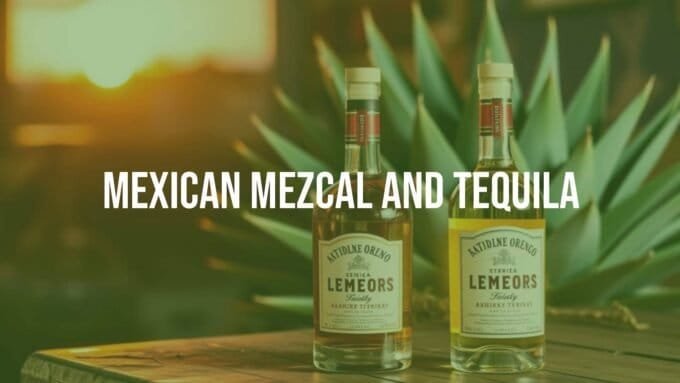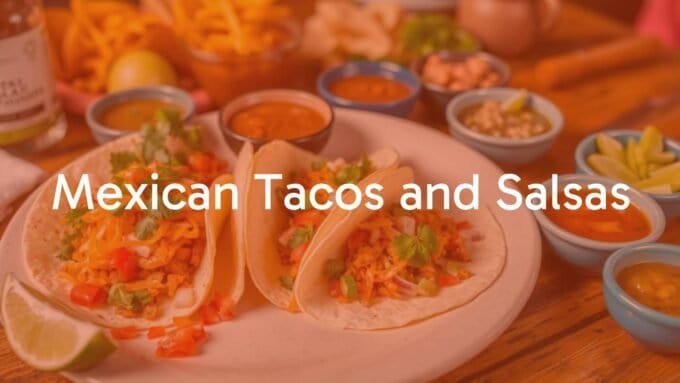What makes Mexican food truly authentic? This question often leads to passionate conversations, similar to choosing your favorite salsa. Authentic Mexican cooking is not just about popular items like tacos and burritos. Instead, it’s a lively blend of centuries of history, many local customs, and deep respect for native ingredients. The flavors have stories, the cooking ways are handed down over generations, and Mexican food is so important to culture that UNESCO has called it a world treasure. If you have only tried Mexican food at American-style restaurants, you may have missed its real depth: it’s not just about spicy heat, but about careful use of chiles for flavor, as well as its role in traditions and celebrations. Each dish, whether it’s a simple taco from the street or a complicated mole, carries years of tradition and the feeling of eating at home.

What Makes Mexican Food Authentic?
Cultural Meaning and History
Mexican food is closely tied to the country’s customs, social life, and everyday events. It’s more than daily meals-it’s a way to celebrate and bring people together. The earliest roots go back thousands of years to Mesoamerican civilizations like the Olmec and Maya, who started growing corn and made the nixtamalization process. This important step-soaking and cooking corn in an alkaline solution-makes corn more nutritious. Later groups, such as the Teotihuacanos, Toltec, and Aztecs, kept adding to these food traditions, building a rich food culture before Europeans arrived.
The arrival of the Spanish in the 1500s changed Mexican cooking by adding new food and cooking styles. Over time, these mixed in with the local ways. However, at its core, Mexican food still relies on corn, beans, and chiles. “Sazón,” or the skill to cook with flavor, is considered a special gift and a sign of care for family and friends. This shows just how important food is in Mexican life.
Main Ingredients in Traditional Mexican Food
The base of authentic Mexican cooking is a set of key ingredients. Corn is the most important, used in tortillas, tamales, and drinks like atole. Chiles-of many types-add flavors, not just hotness. Beans, full of protein, have gone hand-in-hand with corn for centuries. Other common local foods include squash, avocados, tomatoes, tomatillos, cacao, vanilla, and some special vegetables like huauzontle and nopal (cactus pads).

The Spanish brought in pork, beef, chicken, dairy (especially cheese), rice, sugar, and spices such as cilantro, oregano, and cinnamon. They also introduced new fruits and vegetables. Together, local food and these additions made Mexican cooking what it is today-full of unique flavors and many choices.
Cooking Methods Passed Down
Traditional Mexican cooking uses old techniques that bring out the best in ingredients. Nixtamalization (soaking corn with lime) is key-it turns corn into masa, which is needed for tortillas and other foods. Though blenders are now widely used, salsas and sauces were once made with a stone mortar called a molcajete, which many still say makes the best taste. Meat is often slow-cooked, like in cochinita pibil, which is cooked in an underground oven for hours.

Frying, brought by the Spanish, is used for crisping tortillas for tostadas or for cooking fillings. These often slow, hands-on methods are ways that families share time together-especially during big events or holidays.
Main Ingredients in Mexican Cooking
Corn and Its Many Uses
Corn is not just food in Mexico-it is a central part of life and tradition. It was first grown and used for cooking thousands of years ago, along with nixtamalization, which turns dry corn into masa dough by soaking and cooking it in limewater. This makes the corn easier to use and more nutritious.
The most common use of masa is to make tortillas, which serve as plates, spoons, and the base of many meals. But corn is needed in many dishes, not just tortillas. It’s used in drinks like atole, in stews such as pozole and menudo, and for tamales, sopes, and gorditas. Corn’s many uses make it a key ingredient in Mexican kitchens.
Chili Peppers: Many Kinds, Many Flavors
Chiles are at the heart of Mexican food and come in many varieties. They are not just for making dishes hot: each chile has its own taste-smoky, sweet, fruity, or even earthy. While some meals are spicy, most Mexican foods use chiles for flavor. Mexico is home to more types of chiles than anywhere else.
Some examples: poblanos are mild and used for chiles rellenos; chipotles are smoked jalapeños; guajillos are fruity and bright; and the habanero is very hot, popular in the Yucatán. While some dishes are spicy, most restaurants also put bowls of different salsas and pickled chiles on the table, so people can add as much or as little heat as they want.
Beans and Other Plant-Based Proteins
With corn, beans have always played a big role in Mexican meals. They were first grown in the region, and together with corn, make a full, healthy protein source-something people understood long ago. Pinto and black beans are the most used, but there are others as well.
Beans are cooked in many ways: whole in pots (frijoles de la olla), mashed and fried (refried beans, or frijoles refritos), or added to stews. They offer fiber and protein and can be the main part of dishes like Frijoles Charros, a bean stew with chorizo.
Herbs and Spices in Mexican Cooking
Herbs and spices bring freshness and depth to Mexican foods. Cilantro is very common, added to salsas and tacos. Epazote gives bean dishes and quesadillas a unique aroma in the central part of the country. Hoja santa, with a taste like anise and pepper, is used in places like Oaxaca and Veracruz.
Other spices-cumin, oregano, cinnamon, cloves, and bay leaves-were introduced by the Spanish and now are always in the pantry. These make the flavor bases for sauces like mole, and for marinades and stews, giving Mexican food its standout taste.
How Spanish Foods Changed Mexican Cooking
When the Spanish arrived, they brought many new foods: meat from animals like beef, pork, and chicken; cheese and other dairy; wheat; rice; sugar; onions; garlic; limes; and oil. They also introduced their own herbs and spices. With them came frying with lard or oil. These foods and ways of cooking mixed with local traditions to give Mexican dishes new tastes and helped start new foods.
At the same time, Spaniards took home new tastes, too-like chocolate and chiles. So, there was an early mixing of food and ideas between continents. Still, even with these changes, most Mexican recipes still keep their local spirit.
Mexican Food Styles by Region
Central Mexico: Tacos, Tamales, Salsas
Central Mexico, including Mexico City, is a crossroads of food from all over the country and has its own special dishes, too. Street food is very important here, and you can find taco stands everywhere, serving up all kinds of fillings, like marinated pork (al pastor), beef (suadero), or even mushrooms for vegetarians. Tamales-corn dough filled and steamed in leaves-are also a daily treat, especially at breakfast or special events.
Almost every plate is served with different kinds of salsa-red (roja), green (verde), and pico de gallo. The region is also home to stews like barbacoa and carnitas, and the famous mole sauces, especially mole poblano. Food here changes and grows over time, showing the lively city culture.
Oaxaca: Famous for Moles and Local Dishes
Oaxaca is sometimes called the food capital of Mexico. It’s known for its “seven moles”-negro, amarillo, coloradito, mancha manteles, chichilo, rojo, and verde. Each mole is made with many ingredients, always including various chiles, nuts, seeds, and spices, and usually takes hours to prepare. Mole negro, which is dark and includes chocolate and chiles, is especially loved.

Oaxaca also cooks with local ingredients like pasilla oaxaqueña chile, hoja santa, and black beans; queso Oaxaca (Oaxaca cheese) is another favorite. Tlayudas-large, crunchy tortillas with beans and toppings-are a must-try, and chocolate made the old way is often used for drinks.
Yucatán: Annatto, Citrus, and Unique Meats
In the Yucatán, food is distinct, shaped by Mayan heritage and other international influences. Annatto (achiote) gives meals their bright red color and a peppery taste, while sour oranges add a tangy zip. The best-known dish here is cochinita pibil-pork marinated in achiote and bitter orange, then slow-cooked underground until soft.
Habanero chiles are common, but usually served on the side. Other favorites are sopa de lima (lime soup), panuchos, and salbutes-all showing off the area’s special flavors.
Northern Mexico: Hearty Meat Dishes and Wheat Tortillas
In the north, the dry land and cattle ranches have shaped the cooking. Meat-especially beef and goat-is the star. Cuts such as machaca (dried shredded beef), arrachera (skirt steak), and cabrito (roast goat) are usual. Grilling over an open fire is popular and fits the ranch life.
Wheat tortillas are more common here than corn, leading to dishes like burritos, which got their start near the border. Cheese and preserved foods, like dried chiles, are also important in these regions.
Veracruz: Seafood and Afro-Caribbean Touches
Veracruz lies on Mexico’s Gulf Coast, where indigenous, Spanish, and African cooking meet. Seafood, such as red snapper cooked with tomatoes, olives, and capers, is everywhere. The Spanish brought herbs like parsley and bay leaves; African influence came through plantains and tropical fruits.
While corn is used, rice is a more common side in Veracruz. Fruits like papaya and mamey add a sweet finish to many local dishes.
Street Food Across Mexico
Street food plays a huge role in daily life, helping people connect with their roots. Tacos are the most popular, but each region has favorites. Northern Mexico likes carne asada tacos, while others go for pork al pastor. Besides tacos, you can find sopes, quesadillas, huaraches, and tlayudas in different parts of the country.
Corn is featured in snacks like elote (grilled corn) and esquites (corn in a cup). Even more filling meals like barbacoa and carnitas are often sold from small street stalls, making home-style tastes available to everyone.
Favorite Traditional Mexican Dishes
| Dish | Main Ingredients | Special Notes |
|---|---|---|
| Pozole | Hominy (corn), pork or chicken, chile, garnishes | Often eaten during holidays; red, green, or white types |
| Mole | Chiles, nuts, seeds, chocolate, spices | Mostly from Oaxaca and Puebla; made for big celebrations |
| Tacos al Pastor | Pork, pineapple, corn tortillas, achiote, chiles | Inspired by kebabs from Lebanese immigrants |
| Chiles en Nogada | Poblano chiles, ground pork, fruits, walnut sauce, pomegranate | Represents the Mexican flag; popular in September |
| Tamales | Corn masa, fillings (meats, beans, cheese, fruits), corn husks or banana leaves | Styles and fillings change by region |
| Carnitas & Barbacoa | Pork for carnitas, beef/lamb/goat for barbacoa | Slow-cooked until tender; served in tacos or alone |
| Enchiladas | Corn tortillas, various fillings, chile sauce | Served with red or green sauce, sometimes cheese |

Popular Salsas, Sides, and Snacks
Different Salsas: Red, Green, Pico de Gallo
Salsas are essential in Mexican cooking-they add color and boost flavors. The main types are:
- Salsa Roja (Red Salsa): Roasted or boiled tomatoes with chiles, onion, garlic, and cilantro. Can be mild or spicy.
- Salsa Verde (Green Salsa): Made from tomatillos and green chiles for a tangy flavor.
- Pico de Gallo: Chopped fresh tomato, onion, jalapeño, cilantro, and lime. It’s chunky, not blended.
How to Make Traditional Guacamole
Guacamole is a creamy, popular dip. The basic recipe is:
- Mash ripe avocados.
- Add lime juice for flavor and to keep it green.
- Mix in finely chopped onion, cilantro, and a bit of jalapeño or serrano chile for a mild kick.
The best guacamole is made with avocadoes that are just ripe. It’s usually made with a stone mortar (molcajete), which gives it great texture.
Snacks: Elote, Esquites, and Chicharrones
- Elote: Grilled corn on the cob, spread with mayo or cream, sprinkled with cheese and chili powder, and finished with lime.
- Esquites: Same idea as elote, but corn kernels served in a cup-easy to eat on the move.
- Chicharrones: Crunchy pork rinds, great with hot sauce or salsa.
These snacks are found at markets, street corners, and fairs, holding a special place in Mexican street culture.
Beans and Rice: Everyday Sides
Mexican rice (arroz rojo, made with tomato) and refried beans (mashed and pan-fried) are basic side dishes. These two together offer a balanced, healthy meal-especially since they provide all essential protein when combined.
Mexican Desserts and Sweets
Chocolate in Mexican Treats
Chocolate comes from Mexico, first used by Aztecs and Maya as a drink with spices, not as a sweet bar. Today, it’s used in hot chocolate and in thick drinks like champurrado (a chocolate-corn drink), as well as in mole sauces for meals.
Favorite Sweets: Churros, Flan, Tres Leches Cake
- Churros: Fried dough sticks covered in sugar, sometimes dipped in chocolate.
- Flan: Creamy caramel custard.
- Tres Leches Cake: Soft sponge cake soaked in three kinds of milk and topped with whipped cream and fruit.

These desserts are found everywhere and often end a special meal.
Fruit-Based Desserts and Breads
- Fresh Fruits: Often eaten with lime and chili powder.
- Sweet breads (pan dulce): Like conchas and bolillos, fill bakeries across Mexico.
- Wedding Cookies and Buñuelos: Sugary, crunchy cookies and fried fritters, made especially for holidays.
Traditional Mexican Drinks
Aguas Frescas: Cool Fruit Drinks
Aguas frescas are light, natural drinks made by blending fruits, flowers, or seeds with water and sugar. Popular flavors are watermelon, cantaloupe, pineapple, jamaica (hibiscus), and tamarind. They’re everywhere-from markets to street stalls.
Classic Hot Drinks: Mexican Hot Chocolate and Atole
- Mexican Hot Chocolate: Melted chocolate tablets mixed with milk or water, frothed and flavored with cinnamon.
- Atole: A warm, thick drink made of corn masa; it can be flavored with vanilla, cinnamon, fruit, or chocolate (as champurrado).
These are popular for breakfast or evening snacks, and often served with tamales.
Mexican Spirits: Tequila, Mezcal, and Pulque
- Tequila: Made from blue agave, most often in Jalisco. Clear when young (blanco), or aged for a smoother taste (añejo).
- Mezcal: Made from different agaves and has a smoky flavor. Most mezcal comes from Oaxaca.
- Pulque: Fermented agave sap, with a slightly sour, milky texture. An old traditional drink, now making a comeback.
- Charanda: A sugarcane spirit from Michoacán.
Popular Non-Alcoholic Drinks: Horchata and Jamaica
- Horchata: Sweet, cool drink made from rice, with vanilla and cinnamon flavor. Brought by the Spanish but now a local favorite.
- Agua de Jamaica: Tea made from dried hibiscus petals, it’s bright red and both tart and sweet.
The Difference Between Real and “Mexican-Style” Food Abroad
How Mexican Dishes Change Outside Mexico
When Mexican food is cooked in other countries, especially in the U.S., it often adjusts to local tastes and ingredients. This leads to “Tex-Mex” or “American Mexican” food, which uses more cheese, bigger portions, and sometimes less flavor variety. Flour tortillas are used more than in Mexico, and there are usually fewer types of chiles. Quick cooking and shortcuts change the taste and look of traditional dishes.
Real Mexican Food vs. Foreign Versions
For example, the taco: in Mexico, tacos are small, served on corn tortillas, filled simply, and topped with onion, cilantro, and salsa. Elsewhere, they might be fried hard shells with ground beef, yellow cheese, and lettuce-combinations not popular in Mexico.
Burritos, as known in the U.S., are much larger than in Mexico and filled with many extras. Chimichangas are another example-these deep-fried burritos are mostly found in northern Mexican-American cooking. Real enchiladas focus on sauce, while foreign ones often have lots of cheese and a basic red sauce.
How to Find Real Mexican Food Abroad
- Look for fresh ingredients and mention of regional dishes, not just generic “Mexican” food.
- Corn tortillas are a good clue-especially if made fresh.
- Menus with dishes named for places (like “Oaxaca mole” or “Yucatán cochinita pibil”) are usually more traditional.
- Lots of salsa types on offer means careful attention to flavor.
- Small, family-run spots or food trucks, especially in areas with Mexican communities, are a good bet.
- Ask how a dish is made; real cooks are usually happy to explain.
- Real Mexican food has balanced flavors-not just spicy, but sweet, sour, and salty, too.
Common Questions About Real Mexican Food
What Is the Most Popular Mexican Dish?
“Taco” is the answer that comes up most, since tacos are eaten everywhere, at all times. They’re quick, come in many styles, and are loved by everyone. Other favorites include tamales, enchiladas, and stews like pozole-especially for special occasions.
Is All Mexican Food Spicy?
This is a common myth. Chiles are used for flavor and variety, not just spiciness. Most chiles in Mexico are mild or flavorful-like poblano or ancho. Hot sauces or chopped chiles are usually offered on the side, so each person can adjust as they like.
How Can You Tell If Food Is Authentic?
- Corn tortillas, especially fresh, point to tradition.
- A range of salsas, using different types of chiles.
- Fresh toppings like cilantro, onion, and lime instead of lots of melted yellow cheese.
- Regional names and dishes (for example, mole from Oaxaca or cochinita pibil from the Yucatán).
- A good mix of flavors, not just heat or richness.
What Are Common Misconceptions About Mexican Food?
- Not all Mexican food is spicy; chiles can be mild or full of flavor.
- Mexican cooking is not always heavy or greasy-many dishes are fresh and healthy, full of vegetables and lean proteins.
- Cheese is not used in huge amounts everywhere. It is more common in the north.
- Many “Mexican” foods popular abroad-like hard-shell tacos, U.S.-style burritos, and chimichangas-are not traditional Mexican dishes.
- Mexico has many regional cuisines, not just one cooking style or set of dishes.














Leave a comment